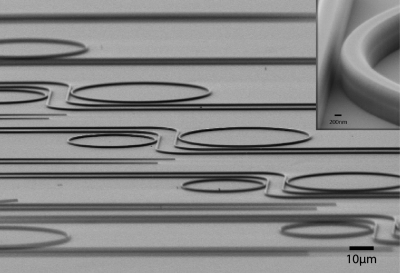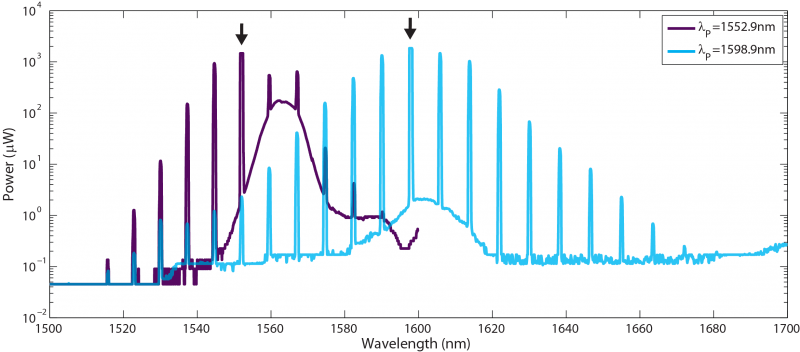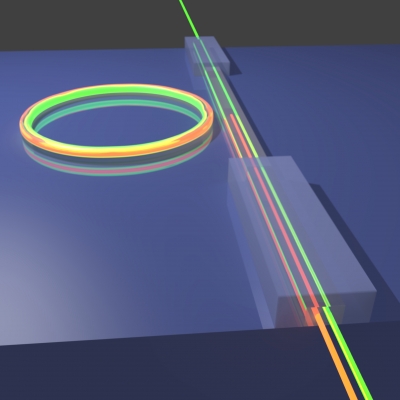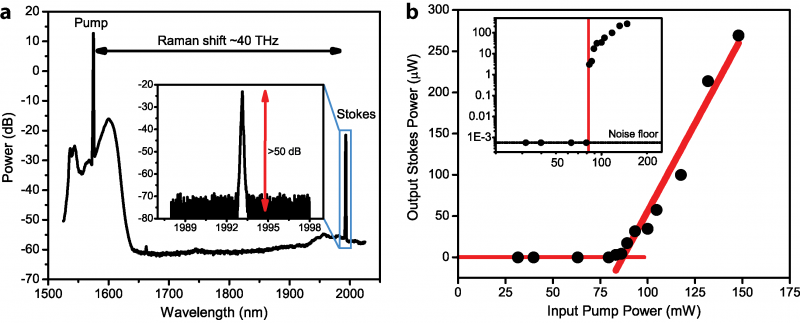Synthetic single-crystal diamond has recently emerged as a promising material for nonlinear photonics due to its large bandgap (~5.5eV) resulting in an ultrawide transparency window (UV - THz), large linear (~2.4) & nonlinear (similar to SiN) refractive indices, absence of multi-photon & free-carrier absorption losses, and high power-handling capability via excellent thermal properties (largest thermal conductivity and small thermo-optic coefficient).
 |
We have developed novel nanofabrication techniques to make low-loss nanowaveguides and high quality-factor (Q ~ 1 million) microresonators in an integrated, on-chip diamond-on-insulator platform.
Our goal is to build novel light sources across a broad spectrum using nonlinear optical interactions in diamond for applications ranging from spectroscopy, sensing and biomedical to telecommunication and classical & quantum information processing. As an example, we have demonstrated a multi-color 'frequency-comb' source at telecom wavelengths (~1600nm) through cascaded four-wave-mixing due to diamond's parametric third-order nonlinearity in high-Q microring resonators integrated onto a silicon chip [Nature Photon. 8, 369 (2014)].
A strong monochromatic pump laser coupled into a resonance of the diamond microring generates coherent light at additional wavelengths at equally spaced adjacent cavity resonances (FSR ~ 100s of GHz in our case). We observed such a frequency comb of 20 new wavelengths spanning a bandwidth of ~10% of the center frequency with <100mW of input pump power. Our work was highlighted in the Sep. 2014 issue of Laser Focus World. We are currently working towards extending this on-chip frequency-comb technology in diamond to novel wavelength ranges in the optical spectrum, particularly the visible frequency range where it has been difficult to achieve with other traditional nanophotonic materials.
 |
As another example, we have demonstrated an on-chip Raman laser operating at the highly-sought-after ~2 micron wavelength range, identified for next-generation telecommunication networks, using integrated, high-Q, oval-shaped long path-length racetrack microresonators in diamond [Optica 2, 924 (2015)].
 |
Diamond's giant Raman shift (~40THz) and large Raman gain (~10cm/GW) coupled with the availability of synthetically-grown, low-cost single-crystal diamond plates have piqued interest in diamond-based Raman lasers. Our telecom-laser-pumped on-chip device operated in continuous-wave mode and reduced the threshold power by orders of magnitude to <100mW. We further showed discrete tuning capability (in steps of the microcavity FSR) over >5% of the center frequency of operation, and also continuous tuning of the diamond Raman laser over a range of ~10 GHz. Our work was highlighted in the Oct. 2015 issue of Optics & Photonics News. We are working towards extending this on-chip Raman laser technology in diamond to novel wavelength ranges in the optical spectrum, particularly the visible frequency range.
 |